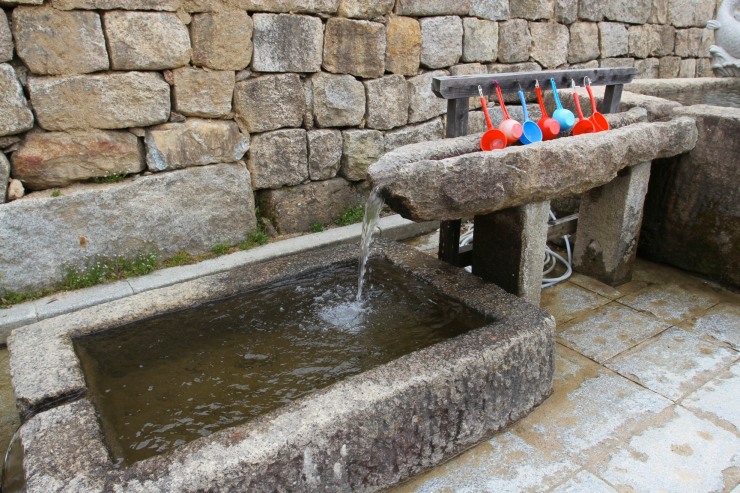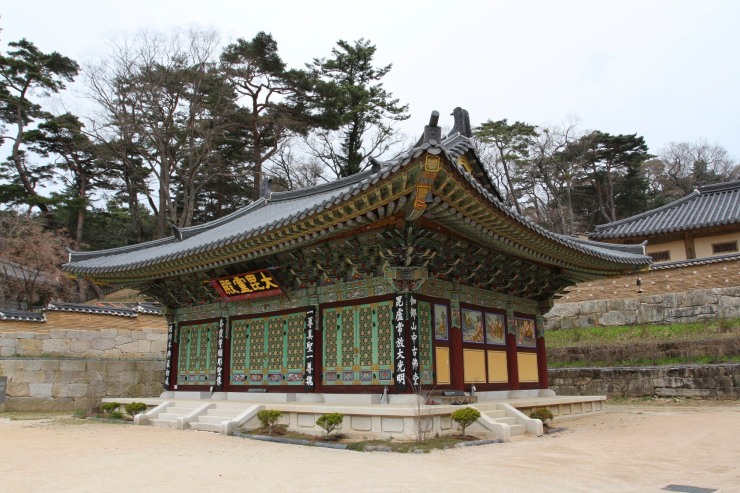The highlight of a visit to the temple complex of Haeinsa is undoubtedly the Tripitaka Koreana, the 80,000 strong archive of Buddhist scripts engraved on wooden blocks dating from the 13th Century. To reach it you progress upwards, ascending several terraces as if to enlightenment itself.
The thing is, the Tripitaka is hardly ever open to the public; to catch a glimpse of this extraordinary library you have to peer through slatted windows from several feet away. I’ve seen photos and it’s amazing, but the experience of not really seeing the Tripitaka Koreana was a bit underwhelming.
Luckily the temple complex itself, set on a wooded hillside overlooking the valley below, is wonderful for wandering. The Temple was first constructed in 802 AD, just after Buddhism arrived in Korea from China. It has been renovated or rebuilt following fire damage at various points in time, but the setting feels ancient and timeless, even with a few modern additions poking out from behind buildings. The idea of a continuous line of monks walking these grounds for well over a thousand years is quite staggering.




Walking to the temple you pass along an avenue and through several gates before clambering up some stairs into the first courtyard. Here was a sight I’d never seen before, a sort of prayer maze of brightly coloured lanterns. People enter the maze and walk through four quarters of different colours undertaking their devotions before exiting again. I’ve been to numerous Buddhist temples but haven’t seen anything similar.
Up more stairs you enter a higher, inner courtyard surrounded by wooden buildings, none of which were open to the public. Yet more stairs – enlightenment comes only with firm leg muscles it would seem – led to a big temple on a terrace above. It was a short walk up, you guessed, more stairs to where the Tripitaka Koreana is located. This is the highest building in the complex, offering beautiful views over the temples and valley below. You can imagine how tranquil it must be for the monks once all the day tripping visitors have left.





If you want to experience that tranquility firsthand, you can stay overnight in the temple and participate in the activities of the monks. I gave this some thought, but when I discovered I’d be sleeping on a floor and the morning wake up call was 3am, I demurred. I had plans to go walking the next day and getting some sleep seemed like a good idea. After all, 3am is essentially still night.
I spent several hours wandering around the monastery and nearby trails, before heading back into the village to find food. It’s clear the village survives on tourism, which meant that in a tiny place there were lots of places to eat. Fortified, I headed back to my hotel room and it’s absurdly hot heated floor (I never worked out how to turn the heating down), to get a good night’s sleep.




I woke early the following morning in full expectation of spending the morning walking through the surrounding woodland before heading back to Daegu. Throwing back the curtains I discovered that the cloud was so low I could no longer see the woodland, and it was raining. It was raining a lot. Giving up the walking idea, and hoping for better weather out of the hills, I made my way to the bus station and to Daegu, not realising that the rain was here to stay for the next 48 hours.




Is that a reversed Swastika on one of the temples?
It’s a widely used in Buddhism, especially in Korea, it’s auspicious and signifies good fortune. I’ve seen it a lot in Hinduism as well, similar meaning. Always clockwise as opposed to the counterclockwise swastika of the Nazis. First time I saw one in India was a bit of a shock though.